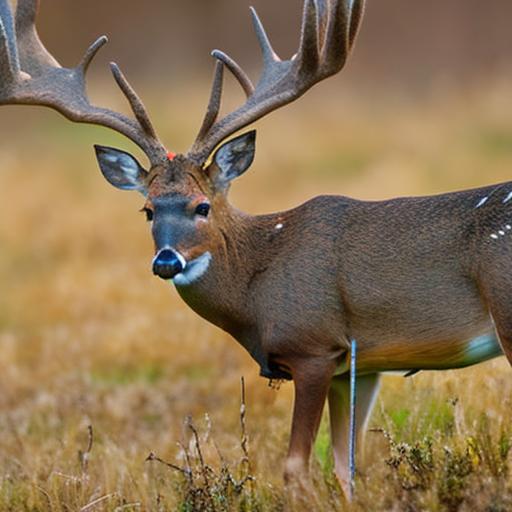Your cart is currently empty!

muzzleloader deer hunts

Muzzleloader deer hunting is a popular choice among hunters for several reasons. It offers a unique and challenging experience that requires skill and precision. In addition, using a muzzleloader allows hunters to connect with the rich history of hunting and experience the thrill of using a traditional firearm. This article will explore the world of muzzleloader deer hunting, including what a muzzleloader is, how it works, the advantages and disadvantages of using one, safety tips, choosing the right muzzleloader and ammunition, cleaning and maintenance, strategies for success, understanding deer behavior, preparation, and ethical considerations.
Key Takeaways
- A muzzleloader is a type of firearm that uses black powder or a substitute to propel a bullet or shot for hunting.
- Advantages of using a muzzleloader for deer hunting include longer hunting seasons, increased challenge, and historical significance, while disadvantages include longer reload times and limited range.
- Safety tips for muzzleloader deer hunts include always treating the firearm as if it is loaded, wearing appropriate safety gear, and being aware of your surroundings.
- Choosing the right muzzleloader for your deer hunting needs involves considering factors such as accuracy, ease of use, and personal preferences.
- The best muzzleloader ammunition for deer hunting depends on the type of firearm and the hunter’s specific needs, but options include sabot bullets and round balls.
- Proper cleaning and maintenance of your muzzleloader is crucial for safety and performance, including cleaning after each use and storing in a dry, cool place.
- Strategies for successful muzzleloader deer hunting include scouting the area beforehand, using scent control, and being patient and still while hunting.
- Understanding deer behavior and habits is important for muzzleloader hunting, including knowing their feeding and bedding patterns and how they react to different weather conditions.
- Preparing for a muzzleloader deer hunt involves practicing shooting and familiarizing yourself with the firearm, as well as packing appropriate gear and supplies.
- Ethical considerations for muzzleloader deer hunting include respecting the animal and its habitat, following hunting regulations, and using the meat and other parts of the animal responsibly.
What is a muzzleloader and how does it work for deer hunting?
A muzzleloader is a type of firearm that is loaded from the muzzle or open end of the barrel. Unlike modern firearms that use cartridges or shells, muzzleloaders require the shooter to measure and pour gunpowder down the barrel, followed by a projectile such as a bullet or shot. The gunpowder is ignited by a small spark created by a flintlock or percussion cap mechanism.
Muzzleloaders differ from other firearms in several ways. Firstly, they have a slower rate of fire due to the time it takes to reload after each shot. This adds an element of challenge and excitement to the hunting experience. Secondly, muzzleloaders have limited range compared to modern rifles. This means that hunters must get closer to their target and rely on their stalking and concealment skills to be successful.
The advantages and disadvantages of using a muzzleloader for deer hunting
Using a muzzleloader for deer hunting has several advantages. One of the main benefits is the increased challenge it offers compared to using modern firearms. Muzzleloaders require hunters to be more patient and precise in their shots, as they only have one opportunity before needing to reload. This adds an element of skill and strategy to the hunt.
Another advantage of using a muzzleloader is the increased accuracy it provides. Muzzleloaders are known for their exceptional accuracy, especially when using the right ammunition and practicing proper shooting techniques. This can result in cleaner and more ethical kills, as well as a greater sense of accomplishment for the hunter.
However, there are also some potential drawbacks to using a muzzleloader for deer hunting. One of the main disadvantages is the longer reload times compared to modern firearms. It can take several seconds or even minutes to reload a muzzleloader, which can be a disadvantage if a hunter needs to take a follow-up shot quickly. Additionally, muzzleloaders have limited range, typically around 100-200 yards depending on the specific firearm and load used. This means that hunters must get closer to their target and may need to rely on their stalking and concealment skills more heavily.
Safety tips for muzzleloader deer hunts
Safety should always be the top priority when participating in any form of hunting, and muzzleloader deer hunting is no exception. Here are some essential safety tips for hunters using muzzleloaders:
1. Always wear eye and ear protection: Muzzleloaders produce loud noises and can create debris when fired. Wearing proper eye and ear protection will help prevent injuries.
2. Keep the muzzle pointed in a safe direction: Always keep the muzzle pointed away from yourself and others. Treat every muzzleloader as if it is loaded, even if you believe it to be empty.
3. Use proper loading techniques: Follow the manufacturer’s instructions for loading your muzzleloader correctly. Improper loading can result in misfires or other dangerous situations.
4. Be aware of your surroundings: Before taking a shot, make sure you have a clear line of sight and know what is beyond your target. Avoid shooting near roads, buildings, or other people.
5. Practice good firearm handling: Always keep your finger off the trigger until you are ready to shoot. Keep the muzzle pointed in a safe direction at all times, even when not actively hunting.
Choosing the right muzzleloader for your deer hunting needs
When it comes to choosing a muzzleloader for deer hunting, there are several factors to consider. The first decision to make is whether to go with a traditional muzzleloader or a modern inline muzzleloader. Traditional muzzleloaders, such as flintlocks or percussion cap rifles, offer a more authentic and historical experience. However, they can be more challenging to use and require additional maintenance.
Modern inline muzzleloaders are designed to be more user-friendly and offer improved accuracy and reliability. They typically use a 209 shotgun primer for ignition and have features such as scopes and synthetic stocks. These firearms are often preferred by hunters who want the benefits of a muzzleloader without the added complexity.
Another consideration when choosing a muzzleloader is the type of ignition system. Flintlock muzzleloaders use a piece of flint to create sparks that ignite the gunpowder, while percussion cap muzzleloaders use a small metal cap containing a primer compound. Both systems have their advantages and disadvantages, so it’s important to choose one that suits your preferences and shooting style.
The best muzzleloader ammunition for deer hunting
Choosing the right ammunition for your muzzleloader is crucial for successful deer hunting. There are several types of ammunition available, including round balls, conical bullets, and saboted bullets.
Round balls are traditional projectiles that are typically made of lead. They are simple and effective but may lack the long-range accuracy of other types of ammunition. Conical bullets are elongated projectiles that offer improved aerodynamics and accuracy compared to round balls. They come in various weights and designs, allowing hunters to choose the best option for their specific firearm.
Saboted bullets are another popular choice for muzzleloader deer hunting. These bullets consist of a smaller caliber bullet encased in a plastic sleeve or sabot. The sabot helps improve the bullet’s accuracy and allows for higher velocities and flatter trajectories. This can be advantageous when hunting at longer ranges.
Ultimately, the best ammunition for deer hunting with a muzzleloader will depend on factors such as the specific firearm, hunting conditions, and personal preference. It’s important to experiment with different types of ammunition and find what works best for you.
The importance of proper cleaning and maintenance of your muzzleloader
Proper cleaning and maintenance are essential for ensuring that your muzzleloader functions safely and reliably. After each use, it’s important to thoroughly clean the barrel and other components to remove any residue or debris.
To clean a muzzleloader, start by removing the breech plug or nipple and soaking it in a cleaning solution. Use a cleaning rod with a patch or brush attachment to clean the barrel, making sure to remove any fouling or residue. Once the barrel is clean, dry it thoroughly and apply a light coat of oil to prevent rust.
Regular maintenance is also important for keeping your muzzleloader in good working condition. This includes checking for any signs of wear or damage, lubricating moving parts, and ensuring that all screws and fittings are tight.
Strategies for successful muzzleloader deer hunting
To increase your chances of success when using a muzzleloader for deer hunting, it’s important to employ effective strategies. One of the first steps is scouting the area where you plan to hunt. Look for signs of deer activity such as tracks, rubs, scrapes, and droppings. This will help you determine where to set up your stand or blind.
When setting up for a muzzleloader hunt, it’s important to choose a location that provides good visibility and shooting lanes. Look for areas with natural funnels or pinch points where deer are likely to travel. It’s also important to consider wind direction and thermals to avoid alerting deer to your presence.
Another strategy for successful muzzleloader deer hunting is to practice shooting from various positions and distances. Muzzleloaders require a different shooting technique compared to modern firearms, so it’s important to become familiar with your firearm and develop good shooting habits. Practice shooting from different positions such as standing, kneeling, and sitting, and practice shooting at different distances to improve your accuracy.
Understanding deer behavior and habits for muzzleloader hunting
Understanding deer behavior and habits can greatly increase your chances of success when using a muzzleloader for hunting. Deer are creatures of habit and tend to follow predictable patterns, especially during the hunting season.
One important aspect of deer behavior to understand is their feeding patterns. Deer are most active during the early morning and late afternoon hours when they are feeding. By scouting and identifying areas where deer are feeding, you can increase your chances of encountering them during your hunt.
Deer also have specific travel routes that they use regularly. These routes are often referred to as deer trails or game trails. By identifying these trails and setting up near them, you can intercept deer as they move between feeding and bedding areas.
During the rut, or breeding season, deer behavior can change dramatically. Bucks become more active and aggressive as they search for mates. This can present opportunities for hunters using muzzleloaders, as bucks may be more susceptible to calling and decoying techniques.
How to prepare for a muzzleloader deer hunt
Proper preparation is key to a successful muzzleloader deer hunt. Here are some tips to help you prepare:
1. Practice shooting: Spend time at the range practicing shooting your muzzleloader from various positions and distances. This will help you become familiar with your firearm and improve your accuracy.
2. Pack the right gear: Make sure you have all the necessary gear for your hunt, including appropriate clothing, boots, binoculars, calls, and scent control products. It’s also important to pack extra ammunition, cleaning supplies, and any other accessories you may need.
3. Scout the area: Before your hunt, spend time scouting the area where you plan to hunt. Look for signs of deer activity and identify potential stand or blind locations.
4. Check regulations: Familiarize yourself with the hunting regulations in your area, including any specific rules or restrictions for muzzleloader hunting. Make sure you have the necessary licenses and permits.
5. Plan your hunt: Develop a plan for your hunt, including where you will set up, how you will access your hunting location, and what time of day you will hunt. Consider factors such as wind direction and thermals when planning your approach.
Ethical considerations for muzzleloader deer hunting
Ethical hunting practices are essential for ensuring the sustainability of wildlife populations and maintaining the integrity of the sport. When participating in muzzleloader deer hunting, it’s important to adhere to ethical guidelines and principles.
One of the main ethical considerations is ensuring a clean and humane kill. This means taking shots that are within your effective range and aiming for vital organs to ensure a quick and humane death. It’s also important to be patient and wait for a clear shot rather than taking risky shots that could result in wounding or injuring the animal.
Respecting the animal is another important ethical consideration. This includes handling harvested animals with care and using all parts of the animal that are edible or usable. It also means avoiding unnecessary suffering by dispatching wounded animals quickly and humanely.
Finally, ethical hunters always follow hunting regulations and laws. This includes obtaining the necessary licenses and permits, adhering to bag limits, and following any specific rules or restrictions for muzzleloader hunting in your area.
Muzzleloader deer hunting offers a unique and challenging experience for hunters. It requires skill, patience, and precision, but can be incredibly rewarding. By understanding what a muzzleloader is, how it works, the advantages and disadvantages of using one, safety tips, choosing the right muzzleloader and ammunition, cleaning and maintenance, strategies for success, understanding deer behavior, preparation, and ethical considerations, hunters can increase their chances of success and have a memorable hunting experience. So why not give muzzleloader deer hunting a try and experience the thrill of connecting with nature and history?
If you’re interested in muzzleloader deer hunts, you might also enjoy reading our article on “Duck Hunting for Dummies.” This comprehensive guide provides valuable tips and techniques for beginners looking to embark on their first duck hunting adventure. From choosing the right gear to understanding duck behavior, this article covers everything you need to know to have a successful hunt. Check it out here.
FAQs
What is a muzzleloader?
A muzzleloader is a type of firearm that is loaded from the muzzle end of the barrel, rather than the breech end. It is typically used for hunting and shooting sports.
What is a muzzleloader deer hunt?
A muzzleloader deer hunt is a type of hunting where hunters use muzzleloading firearms to hunt deer. This type of hunting is typically done during a specific season and requires a special license.
What are the benefits of using a muzzleloader for deer hunting?
Using a muzzleloader for deer hunting can provide a more challenging and rewarding hunting experience. It also allows hunters to connect with the history of hunting and firearms.
What are the regulations for muzzleloader deer hunting?
Regulations for muzzleloader deer hunting vary by state and can include specific seasons, bag limits, and licensing requirements. It is important for hunters to check their state’s regulations before hunting.
What are some tips for muzzleloader deer hunting?
Some tips for muzzleloader deer hunting include practicing shooting and reloading techniques, scouting the hunting area beforehand, and using scent control methods to avoid detection by deer. It is also important to follow all safety guidelines and regulations.

Herb has been a longtime lover of the outdoors. Whether it be hunting, camping, fishing or just getting outside to reset. Proud father and animal lover. Bourbon anyone?

by
Tags:
Comments

Categories
- Big Game Hunting (301)
- Deer (202)
- Reviews (3)
- Shooting (16)
- Slingshot (1)
- Small Game Hunting (42)
- Upland Hunting (126)
- Waterfowl Hunting (3)





Leave a Reply